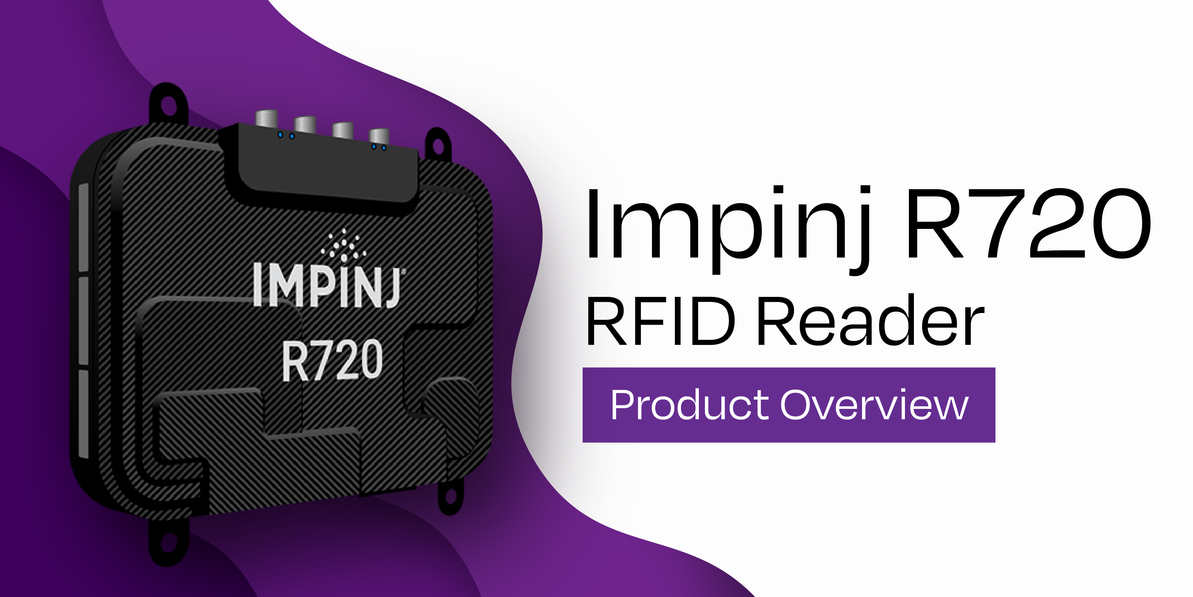Impinj R720 RFID Reader Product Overview
The Impinj R720 RFID Fixed reader proves to be optimal for RAIN deployments demanding processor-intensive on-reader applications and efficient handling of a high volume of tagged items. This device facilitates autonomous reading of individual items in dynamic scenarios, such as at dock doors, conveyors, and other transition points, commonly found in shipping and warehousing environments. Its capabilities shine in situations where items are in constant motion, densely packed, or obstructed by other items.
Features and benefits:
- Increase to 256 MB memory for developing more complex on-reader algorithms and capabilities.
- The ability to read RAIN RFID tags and view tag reports in a web UI while connected to customer applications.
- Impinj IoT Device Interface duration triggers that allow inventory scheduling.
- Advanced general-purpose output (GPO) control, enabling alarms for events like network connection reader operational status, and tag inventory changes.
- An Impinj tag population estimation algorithm that improves read rate by up to 5% when a tag population changes rapidly.
- Developer-friendly tools, multi-antenna support, rich connectivity, and easy transition from the Impinj R700 to the R720 enable quick and efficient development of IoT solutions and speed up time-to-market.
Impinj Fixed Reader Comparison
| FEATURE | IMPINJ R720 | IMPINJ R700 | IMPINJ R420 | IMPINJ R220 |
| Antenna Ports | 4 | 4 | 4 | 2 |
| Read Zones (max) | 32 |
32 |
32 | 16 |
| Read Rate (max per-second) | 1100 | 1100 | 1100 | 200 |
| Transmit Power (max, dBm) | 33.0 | 33.0 | 32.5 | 32.5 |
| Receive Sensitivity* (Typical, dBm) | -93 | -93 | -84 | -84 |
| Processor Speed | 1.4 GHz (quad core) | 1 GHz (dual core) | 400 MHz (single core) | 400 MHz (single core) |
| Random Access Memory (MB) | 1024 | 1024 | 256 | 256 |
| Custom Application Partition (MB) | 256 | 256 | 32 | 32 |
| Impinj IoT device interface | Yes | yes | no | no |
| USB Peripheral Slots | 3 | 3 | 1 | 1 |
| GPIO Connector | Integrated | Integrated | Accessory | Accessory |
| Ethernet Network Speed | 10/100/1000 | 10/100/1000 | 10/100 | 10/100 |
| Power Over Ethernet Support | PoE+ (PoE with reduced Tx Power) | PoE PoE+ | PoE PoE+ EU2 model | PoE |
FAQs:
What are the power requirement differences between the Impinj R700 and Impinj R720?
The Impinj R720 requires approximately 2 watts more power than the Impinj R700. Due to this difference, it is recommended to use PoE+ to power the R720. PoE power is only recommended for the R720 if the device is running a transmit power of 20 dBm or less and is not using any peripherals.
Which male terminal block can I use with the GPIO ports on the Impinj R700 series readers?
One example is PHOENIX CONTACT Printed-circuit board connector.
How can I know which antenna port an Impinj R700 series reader is using to read tags?
The TagMatiks and ItemTest software’s Antenna column automatically displays which antenna port that the Impinj R700 series reader is using to read tags.
What options are available to power the Impinj R700 series readers?
The Impinj R700 series readers are powered exclusively via power over ethernet (PoE or PoE+). Many commercial switches offer this capability. For use cases that require AC connectivity, Impinj sells a midspan injector (P/N IPJ-A2010) that adds PoE+ capability to an existing network connection. There are many commercial off-the-shelf options available for other PoE injecting solutions.
Recent Posts
-
RFID Shielding Box Secure, Accurate RFID Tag Reads
RFID (Radio Frequency Identification) technology has revolutionized asset tracking, inventory manage …Nov 20th 2025 -
Revolutionizing Asset Tracking in 2026 with Zebra RFID Readers
As enterprises scale and supply chains grow more complex, the need for real-time, error-free asset v …Nov 5th 2025 -
Ultimate Comparison of Zebra RFID Printers: Desktop vs. Industrial vs. Mobile
RFID printing is no longer a niche capability—it’s a cornerstone of modern asset tracking, inventory …Oct 22nd 2025




